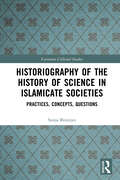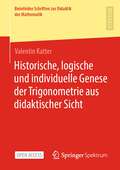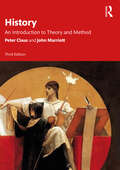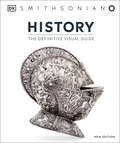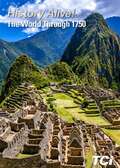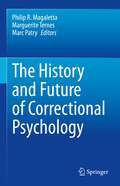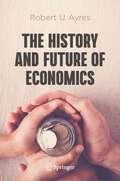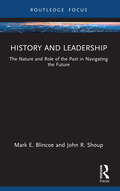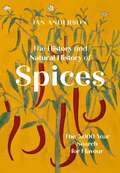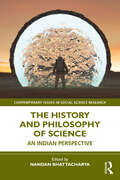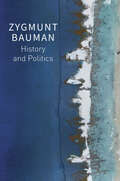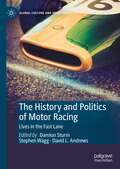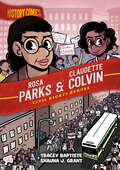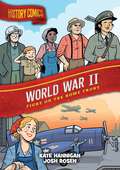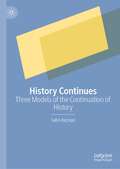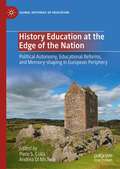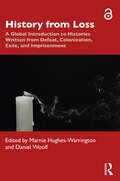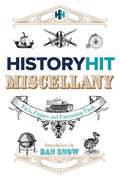- Table View
- List View
Historiography of the History of Science in Islamicate Societies: Practices, Concepts, Questions (Variorum Collected Studies)
by Sonja BrentjesThis book presents eight papers about important historiographical issues as debated in the history of science in Islamicate societies, the history of science and philosophy of medieval Latin Europe and the history of mathematics as an academic discipline. Six papers deal with themes about the sciences in Islamicate societies from the ninth to the seventeenth centuries, among them novelty, context and decline. Two other papers discuss the historiographical practices of historians of mathematics and other disciplines in the nineteenth and twentieth centuries. The central argument of the collected papers is that in addition and beyond the study of scientific texts and instruments historians of science in Islamicate societies need to pay attention to cultural, material and social aspects that shaped the scientific activities of the authors and makers of such texts and instruments. It is pointed out that the diachronic, de-contextualized comparison between methods and results of scholars from different centuries, regions and cultures often leads to serious distortions of the historical record and is responsible for the long-term neglect of scholarly activities after the so-called "Golden Age". The book will appeal in particular to teachers of history of science in Islamicate societies, to graduate students interested in issues of methodology and to historians of science grappling with the unresolved problems of how think and write about the sciences in concrete societies of the past instead of subsuming all extant texts, instruments, maps and other objects related to the sciences under macro-level concepts like Islam or Latin Europe. (CS 1114).
Historische, logische und individuelle Genese der Trigonometrie aus didaktischer Sicht (Bielefelder Schriften zur Didaktik der Mathematik #10)
by Valentin KatterIn diesem Open-Access-Buch führt Valentin Katter eine umfassende didaktisch orientierte Sachanalyse unter historisch-, logisch-, und individualgenetischen Gesichtspunkten durch, mit der es ihm möglich ist, systematisch sechs Grundvorstellungen zum Sinusbegriff zu identifizieren. Anhand detaillierter Videoanalysen zeigt der Autor anschließend, wie diese Grundvorstellungen genutzt werden können, um Denkprozesse von Lehramtsstudierenden in kooperativen Problemlösesituationen zu rekonstruieren. Diese Rekonstruktionen gewähren einen Einblick in das komplexe individuelle Netz von Vorstellungen und ermöglichen es, das Potential und mögliche Hindernisse, die in ihm stecken, auszuloten.
History: An Introduction to Theory and Method
by Peter Claus John MarriottThis book provides an accessible introduction to a wide range of concerns that have preoccupied historians over time. Global in scope, it explores historical perspectives not only from historiography itself but from related areas such as literature, sociology, geography and anthropology which have entered into productive dialogues with history. Clearly written and accessible, this third edition is fully revised with an updated structure and new areas of historical enquiry and themes added, including the history of emotions, video history and global pandemics. In all of this, the authors have attempted to think beyond the boundaries of the West and consider varied approaches to history. They do so by engaging with theoretical perspectives and methodologies that have provided the foundation for good historical practice. The authors analyse how historians can improve their skills by learning about the discipline of historiography, that is, how historians go about the task of exploring the past and determining where the line separating history from other disciplines, such as sociology or geography, runs. History: An Introduction to Theory and Method 3ed is an essential resource for students of historical theory and method working at both an introductory and more advanced level.
History: The Definitive Visual Guide (DK Definitive Visual Encyclopedias)
by DKThis lavishly illustrated visual encyclopedia tells the story of our world in depth and detail from the dawn of civilization to the present day.Charting human endeavor from every angle, SI History chronicles the significant events, ground-breaking ideas, political forces, and technological advances that have shaped our planet. Every historical episode is explored and explained with the help of stunning images that bring the authoritative text to life. Important points in history, from the battle of Hastings and the storming of the Bastille to D-Day and 9/11, have clear but concise coverage, together with profiles of influential figures, such as Julius Caesar, Cleopatra, and Nelson Mandela. It&’s time to head back in time and explore the past with this striking history book, which features: - Profiles of key people who have made history.- Features on inventions, discoveries, and ideas that changed the world.- Graphics lend immediacy and impact to key statistics.- National Histories section separately chronicles key events of every countryAs each moment in history is defined and detailed, supporting panels note the causes and consequences, providing wider context and broadening our horizons. New and enhanced coverage of recent events – such as the Arab Spring – and contemporary issues such as climate change and the COVID-19 pandemic, bring the book firmly into the present. With its broad-themed approach to important historical events, this book shows that ours is a history with genes and viruses, not just battle and treaties – and the stories and biographies of men and women from every corner of the globe who have shaped today&’s world reaffirm that SI History is the story of humankind in which everyone has a part to play.
History Alive! The United States Through Industrialism
by Teachers' Curriculum InstituteNIMAC-sourced textbook
History Alive! The United States Through Industrialism, Interactive Student Notebook (History Alive!)
by Teachers’ Curriculum InstituteNIMAC-sourced textbook
History Alive! The World Through 1750, Interactive Student Notebook
by Teachers’ Curriculum InstituteNIMAC-sourced textbook
The History and Environmental Impacts of Hunting Deities: Supernatural Gamekeepers and Animal Masters (Conflict, Environment, and Social Complexity)
by Richard J. ChaconThis edited volume analyzes the belief in supernatural gamekeepers and/or animal masters of wildlife from a cross-cultural perspective. It documents the antiquity and widespread occurrence of the belief in supernatural gamekeepers at the global level. This interdisciplinary volume documents both the antiquity and the widespread geographical distribution of this belief along with surveying the various manifestations of this cosmology by way of studies from Europe, Asia, Africa, and North and South America. Some chapters explore the manifestations of this belief as they appear in petroglyphs/pictographs and other forms of material culture. Others focus on the environmental impacts of these beliefs/rituals and prescribed foraging restrictions by analyzing how they affect game harvests. The internationally recognized scholars in this volume assess the efficacy of this particular form of traditional ecological knowledge (TEK) and investigate if adherence to the belief in animal masters actually causes hunters to refrain from overharvesting wild game and thereby contributes to sustainable hunting practices. This volume is of interest to anthropologists, archaeologists and other social scientists researching traditional ecological knowledge (TEK), indigenous conservation, biodiversity, and sustainability practices, and animal deities.
The History and Future of Correctional Psychology
by Philip R. Magaletta Marguerite Ternes Marc PatryThis edited volume provides a comprehensive overview of correctional psychology, considering the history and future of the practice. With contributions from expert leaders in the field of correctional psychology – the application of psychological evaluation, treatment, and management of offenders in jails, prisons, and other correctional settings – the early history is presented through a series of brief biographical sketches of the field’s early pioneers. Moving forward, the period of growth and development of key concepts that advanced and matured the field is presented. Finally, directions that remain relevant as the future of correctional psychology unfolds are presented. Ideal for correctional psychology practitioners, students of correctional and forensic psychology, and those interested in the history of psychology, this unique volume traces the ongoing development of a crucial area of psychological practice.
The History and Future of Economics
by Robert U. AyresThe purpose of this book is three-fold. The first purpose is to posit that the fundamental substance of the universe is energy, and that energy is required (consumed) for any material transformation, or information transmission. The labor theory of value, articulated by the physiocrats and elaborated by Adam Smith, David Ricardo, J.B. Say and Karl Marx was a rough first approximation of the value creation process, in the 17th and 18th centuries, but is now obsolete. Labor is now (mostly) performed by machines, not by humans (or animals). The second aim of the book is to argue that the economy is a living (open) system -- an “island of order” –that exists far from both thermodynamic and economic equilibrium. Order is achieved by dissipating a flux of exergy. Economists frequently emphasize the equilibrium assumption, introduced originally by Leon Walras in 1854. But in reality, biological systems and human social systems are dissipative cycles, far from both thermodynamic equilibrium, and economic equilibrium, yet stable and capable of evolution, driven by the solar exergy flux. The third aim of the book is to re-emphasize, that – being open – the economic system cannot be regarded as a collection of individual competitive utility-maximizing transactions. There are, increasingly, important possibilities for cooperation instead of competition. Moreover third party effects, both “bads” (externalities) and the “public good” (happiness) – need to be incorporated into the socio-economic decision making process.
History and Leadership: The Nature and Role of the Past in Navigating the Future (Leadership Horizons)
by Mark E. Blincoe John R. ShoupLeaders and managers are rightly tasked to take their organizations and communities to a desired future. They are expected to be forward looking with compelling vision statements. As a result, they are often too busy in the present managing the future to be bothered with the past. Yet it is organizational histories that provide the contexts and clues for the future. History and Leadership: The Nature and Role of the Past in Navigating the Future demonstrates that intentional historical perspective-taking provides a sort-of wisdom for doing business in the present and future and equips leaders to leverage the past to help their organizations thrive. This book appeals to several audiences. It will serve as a supplementary text for undergraduate and graduate students in both the humanities and leadership studies. The book also appeals to practicing leaders and managers who wish to develop their emotional, cultural, and social intelligence by exploring perennial issues and lessons found in well-developed histories. This book also serves as a stand-alone read for a range of professionals who want a more recreational and non-traditional read on history and leadership. The book cultivates an appreciation for history and equips readers to be connoisseurs of history for the betterment of themselves and society.
The History and Natural History of Spices: The 5,000-Year Search for Flavour
by Ian AndersonSpices have been highly valued since at least the Bronze Age, with the so-called Spice Trade, spanning Asia to the Mediterranean, developing from the late centuries BC. By the first century AD, Roman society spent vast sums fuelling their demand for spices, importing black pepper from India and other exotics from further afield. Importing spices from the east was a daunting and dangerous task, whether by ship across the Indian Ocean, a perilous round journey of many months, or by caravan overland along the myriad routings of the Silk Road, or other trade routes. The search for spices in the 15th and 16th centuries led to Columbus' discovery of America (and the discovery of chilli in Cuba and Hispaniola); Vasco da Gama's proving of the route to India around the coast of Africa; and Magellan's discovery of the western route to the Spice Islands. This comprehensive book both reviews spices and their histories of uses, botanical descriptions and classifications, as well as delving into the trade routes and importance of spice through history in driving global events.
The History and Philosophy of Science: An Indian Perspective (Contemporary Issues in Social Science Research)
by Nandan BhattacharyaThis book provides an in-depth analysis of the history and evolution of the major disciplines of science, which include the basic sciences, bioscience, natural sciences and medical science, with special emphasis on the Indian perspective. While academic interest shown in the history and philosophy of science dates back to several centuries, serious scholarship on how the sciences and the society interact and influence each other can only be dated back to the twentieth century. This volume explores the ethical and moral issues related to social values, along with the controversies that arise in relation to the discourse of science from the philosophical perspectives. The book sheds light on themes that have proved to have a significant and overwhelming influence on present-day civilisation. It takes the reader through a journey, on how the sciences have developed and have been discussed, to explore key themes like the colonial influences on science; how key scientific ideas have developed from Aristotle to Newton; history of ancient Indian mathematics; agency, representation, deviance with regard to the human body in science; bioethics; mental health, psychology and the sciences; setting up of the first teaching departments for subjects such as medicine, ecology and physiology in India; recent research in chemical technology; and even the legacy of ancient Indian scientific discoveries. A part of the Contemporary Issues in Social Science Research series, this interdisciplinary work will be of immense interest to scholars and researchers of philosophy, modern history, sociology of medicine, physical sciences, bioscience, chemistry and medical sciences. It will be of interest to the general reader also.
History and Physical for the Pediatric Dental Patient: Establishing a Systematic Approach for Procedural Sedation
by S. Thikkurissy Sara GolkariThis book serves as a quick reference for all dentists who perform physical exam before the sedation and treatment of pediatric patients. In the dental care setting, pediatric patients present unique challenges to proper sedation and management of dental pathology. A prior history and physical exam is often absent. Learning how to properly conduct a history and physical exam on Pediatric patients is an essential skill for dentists, and has significant implications for parents, patients, and our healthcare system. This book aims for a comprehensive coverage of the review of systems, improve patient care and identify possible complications in pediatric sedation.Each chapter will focus on a single system, discussing its important features and difficulties, and highlighting implications for the dental management. The book includes checklists for practitioners as they go through the physical exam of a pediatric patient, and helps to adequately prepare for comprehensive dental treatment. It includes contributions by leading experts in the field and is structured for quick reference making it a necessary tool in every dental office. This book will bridge the gap between the dental and medical professionals when it comes to the history and physical of the pediatric patient.
History and Politics: Selected Writings, Volume 2
by Zygmunt BaumanA victim of the Nazis, then the communists. Twice a refugee, yet always remaining a committed socialist. In countless ways, Zygmunt Bauman lived the political upheavals of the twentieth and twenty-first centuries. He was an actor within them. Bauman’s own lived history informed his politics, which found expression in varying degrees in his sociology, as he wrote extensively on socialism, democracy, bureaucracy, morality, Europe and the Jewish experience. This volume brings together hitherto unknown or rare pieces by Bauman on the themes of history and politics by drawing upon previously unpublished material from the Bauman Archive at the University of Leeds. A substantial introduction by the editors provides readers with a lucid guide through this material and develops connections to Bauman’s other works. The second volume in a series of books that will make available the lesser-known writings of one of the most influential social thinkers of our time, History and Politics will be of interest to students and scholars across the arts, humanities and social sciences, and to a wider readership.
The History and Politics of Motor Racing: Lives in the Fast Lane (Global Culture and Sport Series)
by Damion Sturm Stephen Wagg David L. AndrewsThis book explores the history and politics of motor racing, one of the most popular and lucrative elements in the international sport industry. Written by a group of international scholars and motor racing specialists it discusses the sport’s origins, the relationship of motor racing to nation building and modernity (noting its links to fascism and dictatorship), the links between motor racing and the automobile industry, motor racing and the politics both of gender and of race, motor racing, the media and postmodernity, and motor racing, the spatial and globalization. This book speaks to scholars in history, politics, sport studies, the sociology of sport, sport management and cultural studies, along with the many lay readers who are interested in the relationship between motor sport and society.
History class 12 - GSTB
by Gujarat State Board of School TextbooksThe textbook for the 12th standard history course by the Gujarat State Board offers a comprehensive overview of India's modern history. It covers significant events and movements from the 18th to the 20th centuries, emphasizing the impact of European colonization and the Indian struggle for independence. The book explores the arrival of various European powers, their interactions with local economies, and the resulting socio-political changes. It highlights key figures and events in the Indian independence movement, illustrating the country's journey from colonial subjugation to sovereignty. The text is supported by archival materials and scholarly research, providing a detailed and factual representation of this period.
History Comics: Civil Rights Heroes (History Comics)
by Tracey BaptisteTurn back the clock with History Comics! In this volume, learn about two brave women who stood up against segregation, setting in motion the Montgomery Bus Boycott!A Black woman who refused to give up her seat on a segregated bus sparked a bus boycott and became part of one of the most iconic moments in American history. Yet, few know that Rosa Parks had actively worked toward social justice her whole life. And even fewer know that the seeds of the statewide bus boycott were first planted by a teenager named Claudette Colvin, who was arrested on similar charges months earlier. Rosa Parks and Claudette Colvin inspired a nation, showing how positive change can start with a single defiant act. Their actions have become the stuff of legend, but there is so much more to their lives, their stories, and the movement they began.
History Comics: Fight on the Home Front (History Comics)
by Kate HanniganTurn back the clock with History Comics! In this volume, learn how millions of Americans joined the fight by working assembly lines, growing vegetables, and collecting scrap metal during World War II!When we think of war, we often focus on the battlefields. But during the war years of 1941 to 1945, Americans at home did whatever they could to support the troops and defeat the Nazis. While millions of soldiers ship out to fight on battlefronts in Europe and the Pacific, millions of men, women, and children step into new and exciting roles in cities and towns all across the United States. Four curious kids take us into factories, farms, and even kitchens to show what the fight on the home front looks like up close!
History Continues: Three Models of the Continuation of History
by Sabri KiçmariDecades after Francis Fukuyama's 'end of history' thesis became famous, the conflicts and turmoil of history have returned; Dr. Kicmari, having seen his own native land erupt in a European civil war in the 1990s, has been thinking about these issues for many years. This book highlights the return of ideology to international relations, presenting harsh ideological models which challenge liberal democracy. This becomes even more relevant in light of the Russian invasion of Ukraine. The publication of this book aims to draw attention to the danger posed to world peace by ideological models alongside the need for commitment to strengthen democracy in the world, and should interest diplomats, journalists, and scholars.
History Education at the Edge of the Nation: Political Autonomy, Educational Reforms, and Memory-shaping in European Periphery (Global Histories of Education)
by Piero S. Colla Andrea Di MicheleThis edited volume explores the evolution of history education from a transnational perspective, focusing on border regions in Europe that are considered on the "periphery" of the Nation-State. By introducing this concept and taking into consideration the dynamics of decentralization and the development of minorities’ teaching practices and narratives, the book sheds light on new challenges for history education policy and curriculum design. Chapters take a comparative approach, dissecting and analyzing specific case studies from school systems in France, Germany, Italy, the UK, and Scandinavian countries. In doing so, the editors and their authors weave a systematic account of the impact of local autonomy on educational culture, on the civic remit of schools, and on the narratives embodied by history school canons.
History from Loss: A Global Introduction to Histories written from defeat, colonization, exile, and imprisonment
by Marnie Hughes-Warrington Daniel WoolfHistory from Loss challenges the common thought that "history is written by the winners" and explores how history-makers in different times and places across the globe have written histories from loss, even when this has come at the threat to their own safety. A distinguished group of historians from around the globe offer an introduction to different history-makers’ lives and ideas, and important extracts from their works which highlight various meanings of loss: from physical ailments to social ostracism, exile to imprisonment, and from dispossession to potential execution. Throughout the volume consideration of the information "bubbles" of different times and places helps to show how information has been weaponized to cause harm. In this way, the text helps to put current debates about the biases and weaponization of platforms such as social media into global and historical perspectives. In combination, the chapters build a picture of history from loss which is global, sustained, and anything but a simple mirror of history made by victors. The volume also includes an Introduction and Afterword, which draw out the key meanings of history from loss and which offer ideas for further exploration. History from Loss provides an invaluable resource for students, teachers, and general readers who wish to put current debates on bias, the politicization of history, and threats to history-makers into global and historical perspectives. The Open Access version of this book, available at www.taylorfrancis.com, has been made available under a Creative Commons Attribution-Non Commercial-No Derivatives 4.0 license.
The History Hit Miscellany of Facts, Figures and Fascinating Finds
by History Hit'History is a bottomless reservoir of all the bonkers, heroic, awful and weird things we eccentric humans have ever done. We can't help generating extraordinary stories... Most importantly, like all the best stories, they are true.' - Dan SnowHave you ever wondered who the third man on the moon was? Did you know that Dick Whittington really was the medieval Mayor of London? Why was a pigeon a hero to the American army? What's the difference between a dolmen and a barrow? Who were the Wu, Wei and Shu Han? Was Napoleon really small? Who said 'Pardon me, sir, I didn't mean to' just before they were executed? When was the oldest known shark attack?The answers to all these questions and so much more are contained within this wonderful miscellany of historical facts, figures and fascinating finds which will enthral, entertain and inform everyone who loves history and wants to know more about more.
